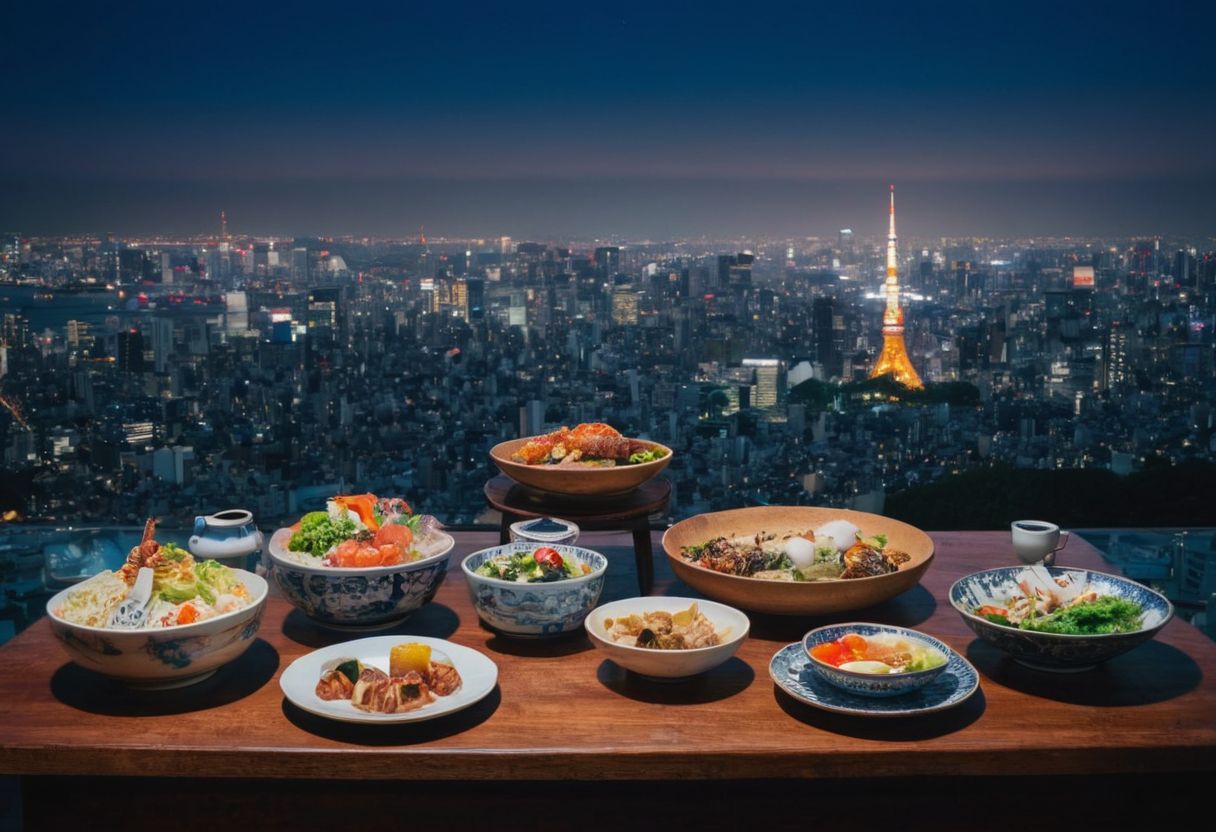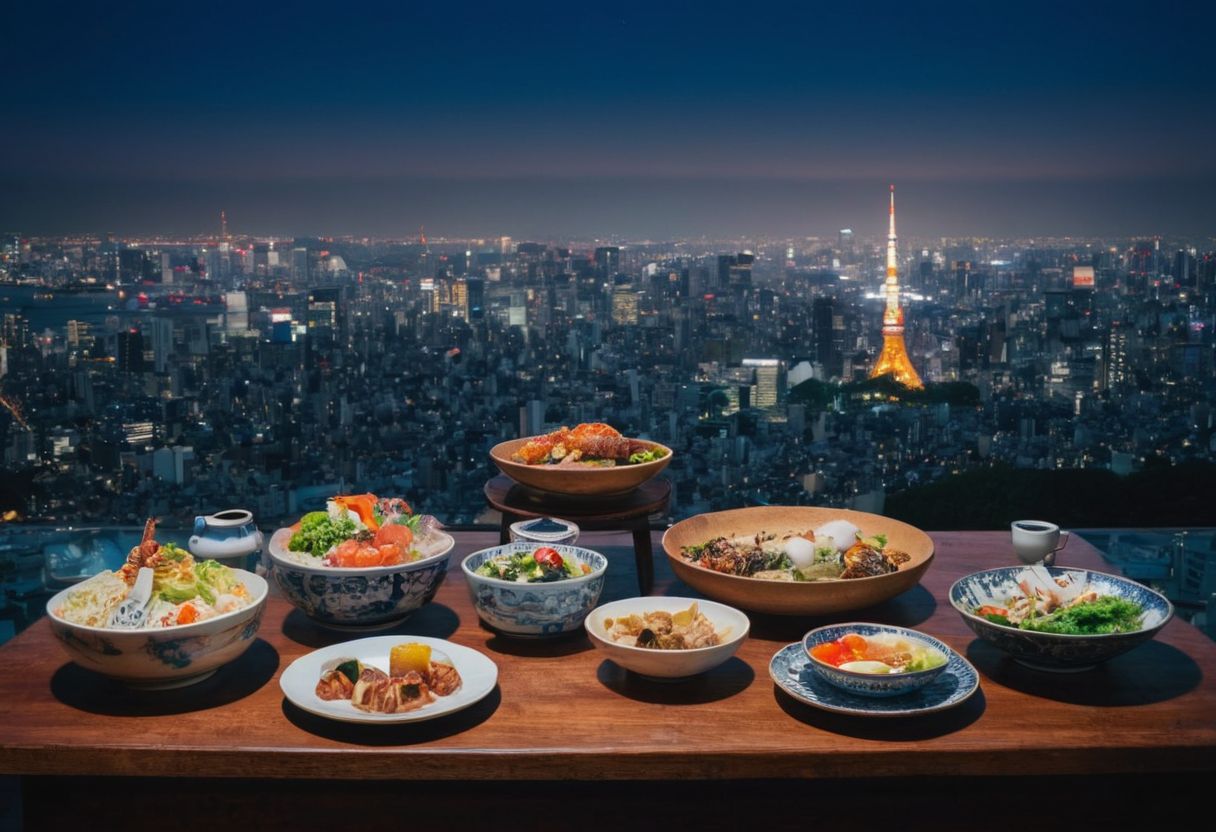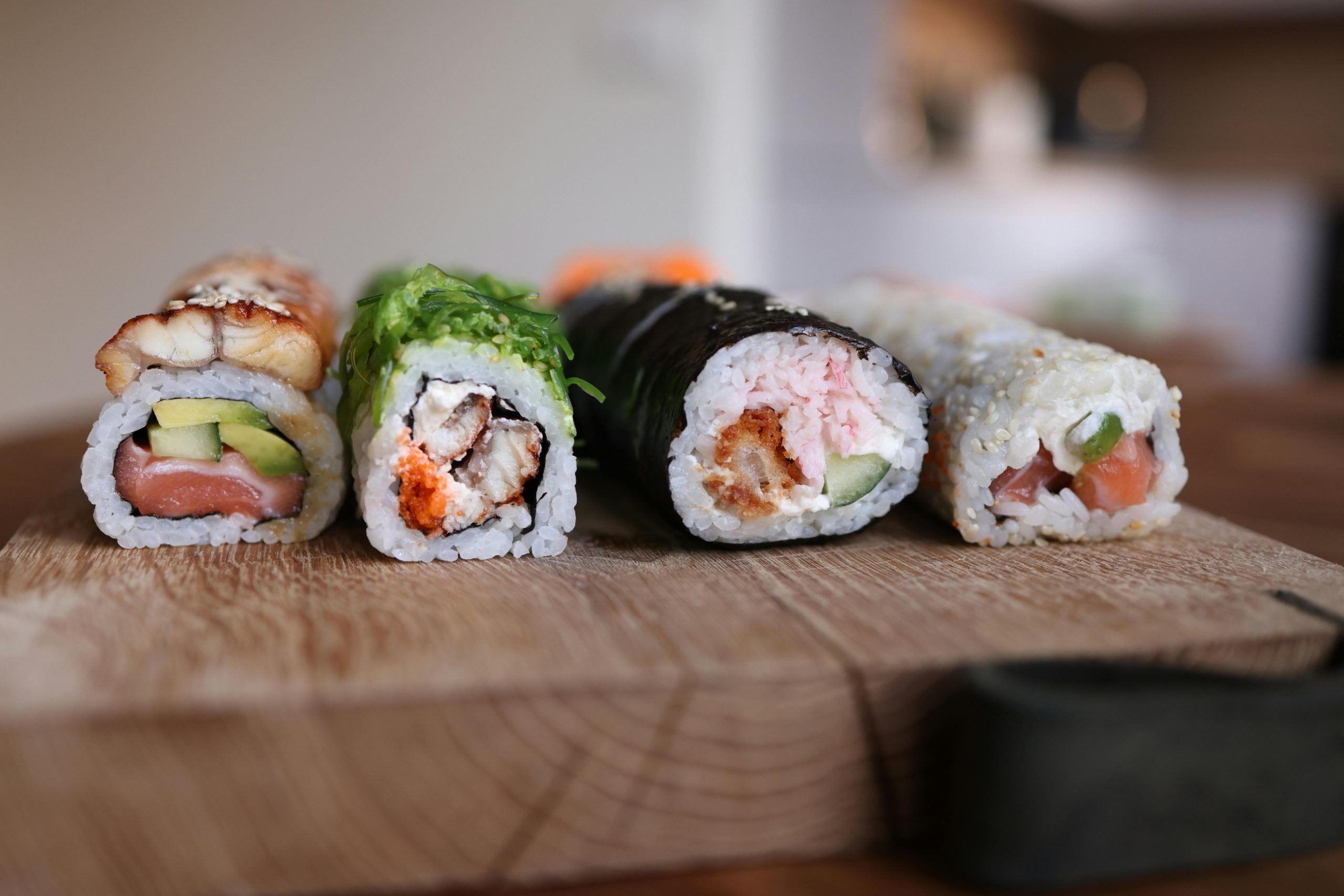Have you ever wondered what makes Japanese fried food so irresistibly crispy and flavorful?
Finding that perfect balance of crunch and flavor can be a culinary challenge.
Japanese fried food, or “agemono,” utilizes expert frying techniques and high-quality ingredients to achieve a delicate, crispy exterior while preserving the juicy, flavorful interior.
In this exploration of Japanese fried food, we’ll delve into the artistry behind popular dishes like tempura, karaage, and katsu, uncover the secrets of their preparation, and discover how each dish offers a unique taste adventure.
Tempura: The Delicate Art of Japanese Frying

Tempura is a quintessential Japanese dish that has been perfected over centuries. Originating in the 16th century, it involves coating ingredients like seafood or vegetables in a light batter and then deep-frying them to achieve a delicate, crispy texture. This cooking style was influenced by Portuguese missionaries and has evolved into a beloved part of Japanese cuisine.
The key to authentic tempura lies in its preparation. A batter made from cold water, flour, and sometimes egg is used to coat the ingredients lightly before they are fried in oil. The result is a golden, airy coating that enhances the natural flavors of the ingredients. Tempura is often served with a dipping sauce made from dashi, mirin, and soy sauce, adding a savory depth to the dish.
Kakiage: Mixed Vegetable Tempura Delight

Kakiage is a delightful variation of tempura that combines thinly sliced vegetables, and occasionally seafood, into a fritter-like form. This mixture is then dipped in tempura batter and deep-fried until crispy. Kakiage is typically enjoyed with a dipping sauce or placed atop a bowl of steaming rice, making for a satisfying meal.
Tonkatsu: Crispy Breaded Pork Cutlets

Tonkatsu, a crispy pork cutlet, is another popular Japanese dish that involves coating slices of pork with panko breadcrumbs and frying them until golden. This dish originated in the late 19th century and is typically served with shredded cabbage, rice, and a rich Worcestershire-based sauce, creating a perfect blend of textures and flavors.
Karaage: Japan’s Favorite Fried Chicken

Karaage, often hailed as Japan’s favorite fried chicken, is celebrated for its incredibly crispy texture and deeply flavorful marinade. The secret lies in marinating bite-sized pieces of chicken, typically thigh, in a mixture of soy sauce, ginger, and garlic. This not only tenderizes the meat but infuses it with rich flavors, setting the stage for its signature taste.
The cooking process of karaage involves coating the marinated chicken in potato starch and then deep frying it to achieve a golden, crispy exterior. This technique ensures that each piece is juicy inside and crunchy on the outside. Often served with a squeeze of fresh lemon, it’s a staple at Japanese home dinners and Izakayas (Japanese pubs), making it a beloved part of Japanese cuisine.
Zangi: Hokkaido’s Take on Fried Chicken

Zangi, a regional take on fried chicken from Hokkaido, offers a distinct twist on the traditional karaage. Known for its robust flavor, Zangi is marinated with a mixture of soy sauce, sake, ginger, and garlic, then coated in a blend of flour and cornstarch for a crispier finish. This variant is deeply rooted in Hokkaido’s local culture, often featured at festivals and as a popular pub snack.
Tebasaki: Savory Japanese Chicken Wings

Tebasaki, or Japanese-style chicken wings, are a savory delight known for their crispy texture and rich flavor. These wings are typically seasoned, coated in a mix of flour and starch, and then deep-fried to perfection. The final touch is a glaze of a sweet and spicy sauce, making Tebasaki a favorite for its blend of crunch and flavor, distinctly different from Western-style chicken wings.
Katsu: A Crunchy Delight in Japanese Cuisine
Katsu, a beloved staple in Japanese cuisine, refers to a variety of breaded, deep-fried cutlets. These delicious cutlets are made from different types of meat such as pork, chicken, or even seafood, each offering a unique flavor and texture. The process involves coating the meat in flour, dipping it in beaten egg, and then covering it with panko breadcrumbs before frying. This method ensures a crispy exterior while keeping the inside tender and juicy.
The popularity of katsu in Japan can be seen in its presence in numerous dishes across the culinary landscape. From the classic Tonkatsu, made with pork, to Chicken Katsu and even variations like Katsudon, where the cutlet is served over rice with egg, this dish has won the hearts of many. Katsu is not only a frequent choice in restaurants but also a favored option for home-cooked meals, demonstrating its versatile appeal.
Korokke: Japan’s Comforting Fried Croquette

Korokke, the Japanese version of the French croquette, is a comforting food item made from mashed potatoes and often mixed with chopped meat or vegetables. These ingredients are shaped into patties, coated in breadcrumbs, and deep-fried until golden. Enjoyed by people of all ages, korokke is commonly served with a side of cabbage and a drizzle of Worcestershire sauce, making it a hearty and satisfying dish. Whether grabbed on the go from a street vendor or made at home, korokke remains a cherished part of Japanese food culture.
Agedashi Tofu: Silky Smooth Fried Tofu

Agedashi tofu is a classic Japanese dish that combines the smooth texture of silken tofu with the delightful crunch of a lightly fried exterior. The tofu is dusted with a thin layer of cornstarch or potato starch and then deep-fried until it achieves a golden, crispy shell. This method ensures that the tofu retains its delicate texture inside while providing a satisfying contrast with its crunchy exterior.
Once fried, the tofu is typically served in a warm, flavorful dashi-based broth, which infuses the dish with umami richness. Key garnishes like grated daikon radish, finely chopped spring onions, and sometimes a sprinkle of katsuobushi (bonito flakes) add fresh, vibrant flavors and textures. The interplay between the hot broth and the crispy tofu creates a delightful sensory experience, making agedashi tofu a beloved dish in Japanese cuisine.
Ebi Fry: Crispy Fried Shrimp Japanese Style

Ebi Fry, or Japanese-style fried shrimp, is a popular dish where shrimp are coated in flour, dipped in beaten eggs, and then rolled in panko breadcrumbs to achieve a perfectly crispy texture. These golden-brown delights are typically served with a tangy soy dipping sauce or a creamy tartar sauce, enhancing the shrimp’s natural sweetness. Ebi Fry is not only a favorite in Japan but has also gained popularity worldwide for its irresistible crunch and flavor.
Takoyaki: Octopus Balls, a Street Food Favorite

Takoyaki, often called octopus balls, is a beloved Japanese street food that captivates both locals and tourists with its unique taste and texture. These tasty morsels are made from a wheat flour-based batter and traditionally filled with diced octopus, giving them a delightful chew amidst a soft, gooey center. The exterior is cooked to a golden crisp, providing a satisfying crunch with every bite.
The preparation of takoyaki involves pouring the batter into a specially designed pan with half-spherical molds. Key ingredients include:
- Diced octopus for the filling
- Pickled ginger and green onions for added flavor
These components are essential for achieving the authentic taste that takoyaki is known for. Once cooked, they are typically drizzled with takoyaki sauce and mayonnaise, then sprinkled with dried seaweed and bonito flakes, enhancing the complexity of flavors.
Okonomiyaki: The Savory Japanese Pancake
Okonomiyaki, often dubbed the Japanese pancake, is a savory dish that’s as versatile as it is delicious. Made from a batter of flour, eggs, and water, it’s mixed with a choice of ingredients like cabbage, seafood, or pork. The beauty of okonomiyaki lies in its regional variations, where each area in Japan adds its unique twist to the basic recipe.
For instance:
- Osaka-style okonomiyaki mixes all ingredients into the batter before grilling.
- Hiroshima-style, on the other hand, involves layering ingredients rather than mixing them, which gives a different texture and flavor.
These regional differences not only highlight the adaptability of okonomiyaki but also the rich culinary diversity found across Japan.
Kushikatsu: Osaka’s Deep-Fried Skewers
Kushikatsu is a beloved dish from Osaka, consisting of skewered meats and vegetables that are battered and deep-fried. This dish offers a variety of flavors and textures, making it a favorite among locals and tourists alike. The skewers are typically dipped in a unique, rich sauce that complements the crispy exterior of the deep-fried food.
The ingredients for kushikatsu can vary widely, but some of the most popular include:
- Beef, pork, and chicken for the deep-fried skewered meat
- Vegetables like onions, green peppers, and eggplants
Each skewer is carefully prepared to ensure it cooks evenly and achieves the perfect crunch, embodying the spirit of Osaka’s vibrant street food culture.
Japanese Street Food: A Yatai Experience
Japanese street food offers a vibrant tapestry of flavors and experiences, with yatai food stalls at the heart of this culinary adventure. These mobile stalls are not just about food; they’re a cultural experience, offering a window into the local lifestyle and traditional eats. From the bustling streets of Fukuoka to the festive atmospheres of Tokyo, yatai serve up an array of dishes that captivate both the palate and the heart.
At a typical yatai, you might find a variety of mouth-watering options:
- Yakitori: grilled chicken skewers that are both juicy and perfectly charred
- Takoyaki: dough balls filled with octopus, a staple in Osaka
- Ramen: especially the Hakata ramen from Fukuoka, known for its rich broth
These offerings make yatai a must-visit for anyone seeking to dive deep into Japan’s street food scene.
Renkon Chips: Crunchy Fried Lotus Root
Renkon Chips, also known as lotus root chips, offer a crispy and unique alternative to regular potato chips. Made from thinly sliced lotus root, these chips are deep-fried to achieve a golden, crunchy texture that is both visually appealing and delicious. The holes in the lotus root slices create a fascinating pattern, making Renkon Chips not only a tasty snack but also a visually intriguing one. Seasoned lightly, they provide a slightly sweet and nutty flavor, making them a popular choice in many Asian cuisines, especially in Japan.
Nankotsu: Exploring Fried Chicken Cartilage
Nankotsu karaage, a unique variant of Japanese fried chicken, utilizes the cartilage of chicken, particularly from the knee and breast areas, offering a distinctively crunchy texture that sets it apart from other fried dishes. This dish is celebrated for its bold texture and the way it holds onto flavors, making it a favorite among those who appreciate a good crunch in their meals. The cartilage is typically marinated in a blend of soy sauce, ginger, and garlic before being lightly coated in flour or starch and deep fried to achieve its signature crispy exterior. Nankotsu karaage is not only a testament to the versatility of deep-fried foods but also a must-try for adventurous eaters exploring the depth of Japanese culinary traditions.
Discover Fried Japanese Food with Indulge’s Culinary Tours
INDULGE offers a unique opportunity to explore the diverse world of fried Japanese food through expertly curated culinary tours. These tours are not just about tasting food; they are educational journeys guided by professional chefs and sommeliers. You’ll get to dive deep into the art of making perfect tempura, karaage, and more, all while enjoying the vibrant atmosphere of Zurich’s food scene.
The benefits of joining an INDULGE tour include:
- Learning directly from food experts about the techniques and secrets behind famous Japanese fried dishes.
- Experiencing a blend of local Swiss and international cuisine, which adds a unique twist to the traditional flavors.
- Gaining a deeper appreciation for culinary arts in a fun and engaging environment, making every tour a memorable adventure.
Frequently Asked Questions
What is Japanese fried food called?
Japanese fried food is commonly referred to as “agemono.”
What is Osaka fried food called?
A popular fried food from Osaka is called “kushikatsu,” which consists of skewered meats and vegetables that are battered and deep-fried.
What is a Japanese dish with fried meat?
Several Japanese dishes feature fried meat, including “tonkatsu,” which is a crispy pork cutlet, and “karaage,” known as Japan’s favorite fried chicken.
What is the difference between tempura and kushikatsu?
Tempura involves coating ingredients like seafood or vegetables in a light batter and deep-frying them to achieve a delicate, crispy texture. Kushikatsu, on the other hand, consists of skewered meats and vegetables that are battered and deep-fried, typically served with a unique dipping sauce. The main difference lies in the ingredients used and the presentation, with tempura focusing on individual items lightly coated in batter, and kushikatsu featuring a variety of skewered items with a heavier batter.








